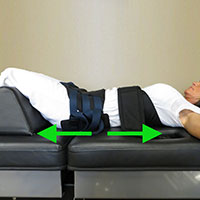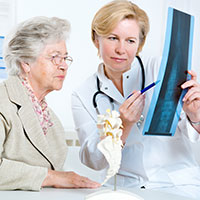Spinal Decompression has been shown to be up to 89% successful in treating the symptoms of Herniated and Bulging Discs. Spinal Decompression creates a negative pressure inside of discs which can draw in herniations and bulges ultimately taking the pressure off of the spinal nerves. Pain levels will then be drastically reduced and numbness and tingling will eventually subside. Click on the Learn more tab to see step by step how this process takes place and what you can expect.
EXPLORE THE NON-SURGICAL PATH TO PAIN FREE LIVING.

Spinal Decompression

Deep Tissue Laser Therapy

Spinal Manipulation

Physical Rehabilitation

Nutritional Supplementation
Conditions We Treat!
Herniated or Bulging Discs
Degenerative Disc Disease
As we age or after injury spinal discs may undergo changes including drying up, thinning, dehydration and poor mobility. This process is referred to as Degenerative Disc Disease. Spinal Decompression successfully treats the symptoms of Degenerative Disc Disease by re-hydrating the discs, improving circulation, increasing disc mobility and increasing disc height ultimately taking the pressure off of pinched nerves. Click on the learn more tab to learn more about its causes and the options for treatment.
Sciatica (Leg Pain)
Sciatica is shooting pain down the leg often accompanied by numbness, tingling and sometimes weakness. Most often Sciatica is caused by a herniated, bulging, or degenerated disc. Spinal decompression has shown amazing results in treating the symptoms of Sciatica. Relief is typically dramatic in as little as 3 to 4 weeks. Click on the Learn more tab to learn about Sciatica, its causes, and your treatment options.
Spinal Stenosis
Spinal Stenosis is narrowing of the spinal cord canal due to bone spurs or bulging discs taking up space. Spinal Decompression can successfully treat spinal stenosis due to bulging discs. Spinal Decompression can reduce bulging discs alleviating the pain, numbness and tingling often associated with irritated spinal nerves. Click on the Learn More tab to see if Spinal Decompression can help you.
Lower Back Pain
Our revolutionary Treatment Protocol has shown to be extremely successful for a variety of lower back pain causes even when physical therapy, chiropractic, massage and pain pills have led to little or no relief. It’s important to determine the exact cause of your low back pain. Once the cause is determined then a specific treatment plan can put in place that will be tailored to your exact condition to ensure you the fastest, most long lasting results.
Failed Back Surgery
With surgery success rates between 25% and 65% many patients are looking for non-surgical alternatives to their neck and back pain. Many are scared to death to go under the knife with possible complications, risk of infection, and no guarantees that they are going to be any better afterwards. Whether you are thinking about having surgery or had a surgery that failed, Spinal Decompression may be an effective, non-surgical option for neck or back pain. Click on the Learn More tab to learn more about all of your options.
Meet Our Doctor
Contact us for your
Frequently Asked Questions
What is Spinal Decompression?
Spinal decompression is a revolutionary computer-aided technology that helps treat the symptoms of low back and neck pain from herniated, bulging, degenerated and slipped discs. Spinal decompression is FDA-cleared and has been around for more than ten years. There have been more than 10 successful research studies on spinal decompression and there are currently more than 5,000 clinics in the U.S. and Canada that are performing spinal decompression treatments. Every day more and more clinics are adding spinal decompression as an alternative to surgery for patients suffering from herniated, bulging, degenerated, and slipped discs. Even when physical therapy, chiropractic, acupuncture, pain pills and shots have failed, most patients still receive dramatic pain relief in 4 to 6 weeks of spinal decompression.
What does Spinal Decompression treat?
FDA cleared Spinal Decompression technology treats symptoms of back pain due to:
- Herniated Discs
- Bulging Discs
- Pinched Nerves
- Sciatica (leg pain)
- Degenerative Discs
- Spinal Stenosis
- Post-Surgical Pain and more…
How Does Spinal Decompression Work?
Decompression is achieved by using a specific combination of force of pull, angle in degree of pull and varying time in order to create a negative pressure inside the discs of the spinal cord. This reversal of pressure creates a vacuum inside the disc that helps to draw in bulging discs and extruded disc material back into place, taking pressure off pinched or irritated nerves. Spinal experts believe that nutrients, oxygen, and fluids are drawn into the disc to create a revitalized environment conducive to healing for both herniated and degenerated discs. Based on the patient’s body weight, tolerance, level of severity, and duration of symptoms your spinal decompression specialist will determine a specific treatment plan based on your individual needs. This helps ensure the best and longest lasting results.
What are the Treatments Like?
At the beginning of each session, you will be comfortably fitted with a harness designed to achieve optimal decompression of the low back or neck. During a session of spinal decompression, you will notice a slow lengthening of your spine as your discs are gradually decompressed and relieved of pressure. The treatment process is safe and relaxing. While some patients with extensively injured discs have reported mild discomfort during the first few treatment sessions, their discomfort generally subsides upon subsequent visits. A patient safety switch provides an extra safety feature, allowing you to stop at any point should you feel discomfort. Each treatment session lasts approximately 30 minutes.
What is the Typical Treatment Protocol?
A typical spinal decompression treatment protocol consists of about 12–20 sessions over four to six weeks. Some conditions require fewer visits; some require more. Many patients report relief from their pain and other symptoms during the first few treatment sessions, and most experience dramatic pain relief after completion of their prescribed treatment program.
Why Would Spinal Decompression Work When Chiropractic, Physical Therapy and Traction Have Failed?
While traction, physical therapy, inversion tables and manipulation may reduce disc pressures to as low as 40 mm Hg, only spinal decompression has been shown to achieve negative pressures within the spine. It has been clinically proven that spinal decompression creates negative pressures as low as -110 mm Hg3 within the injured disc during the treatment session. Normally, pulls exerted on the spine trigger sensory receptors in the back to tighten the muscles surrounding the vertebrae and discs in an effort to protect them from injury, a mechanism in the body known as the proprioceptor response. This typically includes muscle guarding and muscle spasms. Spinal Decompression bypasses this response by slowly pulling on the spine and relaxing the back over an extended period of time, allowing the discs to be repositioned without tension and without setting off muscle guarding and spasms. It is important for patients to make sure that they are treated on a high quality spinal decompression table by a physician with years of experience and not an imitation spinal decompression table to ensure best results.
If I Undergo Spinal Decompression Therapy, How Long Will It Take to See Results?
Based on 6 years of spinal decompression experience and thousands of patients treated we have noticed that the overall success rate is around 80%. We consider this success rate to be very good considering most of our patients have “tried everything else” with minimal or no relief, are at least a 6/10 mVAS pain level and have been experiencing their pain for greater than 6 weeks. About 20% of patients will start seeing relief of pain within the first week. Around 40% of patients will have significant relief within 2–3 weeks. The remaining 20% will get significant relief between 4–6 weeks. Less than 20% will experience no relief or minimal relief. Very rarely will a patient get worse.
Do I Qualify for Spinal Decompression Therapy Treatment?
The following conditions may qualify for spinal decompression treatment. Always consult your spinal decompression specialist to see if you are a candidate for spinal decompression therapy. Candidates for spinal decompression therapy include the following:
- Diagnosis of a herniated, bulging or degenerated disc
- Back pain persisting for more than three weeks
- Recurrent pain from a failed back surgery that is more than six months old
- Persistent pain from arthritis
- Patient at least 18 years of age
Who doesn’t qualify for spinal decompression therapy?
The following conditions may disqualify a patient for spinal decompression treatment. Always consult your spinal decompression specialist to see if you are a candidate for spinal decompression therapy. Candidates that may not qualify for spinal decompression therapy include the following:
- Hardware in the spine such as screws and rods
- Pregnancy
- Prior lumbar fusion less than six months old
- Metastatic cancer (cancer that has spread to the bones
- Grade 3 and 4 spondylolisthesis (Grade 1 or Grade 2 spondylolisthesis are treatable)
- Recent compression fracture of lumbar spine
- Pathologic aortic aneurysm
- Pelvic or abdominal cancer
- Disc space infections
Consult your physician if you have any questions about the conditions above or to find out if you would qualify for spinal decompression therapy.
Are there any Side Effects to the Treatment?
Most patients do not experience any major side effects. The most common side effect is a dull, achy soreness for the first week or two as the body becomes accustomed to being stretched and decompressed. Spinal decompression stretches muscles in a lengthening direction which the body is generally not used to. Because of this patients may experience a dull, achy soreness that they often describe as “it feels like I just worked out for the first time in a long time.” Very rarely do patients have an increase in the pain that they came in with.
Patients with acute, severe disc herniations may experience some pain during the first week or two until the herniation retracts back in taking pressure off of the nerves. Acute disc herniation patients tend to experience more “up and down” types of relief from their pain for the first 2 weeks as an acute disc herniation can be slightly unpredictable. Regardless of the mild soreness experienced in the first week or two, most patients experience 50% relief or more of their pain around the end of the second week.
Overall Spinal Decompression Therapy is considered safe and comfortable. The system has emergency stop switches for both the patient and the operator. These switches terminate the treatment immediately if a patient experiences any increase in pain or discomfort during the treatment thereby avoiding most injuries.
Can Spinal Decompression be Used for Patients that Have had Spinal Surgery?
In many cases Spinal Decompression treatment is not contra-indicated (withheld due to the harm that it would cause the patient) for patients that have had spinal surgery. In fact many patients have found success with Spinal Decompression even after a failed back surgery. After a failed Laminectomy or Micro Discectomy patients may still respond favorably to spinal decompression. If a patient has had more than 3 laminectomies then the success rate of spinal decompression will go down. If a patient has had surgical fusion with rods or screws or any type of hardware then patients may not qualify for spinal decompression. Always consult your spinal decompression specialist to see if you qualify for spinal decompression therapy.
Didn't find the answer?
Contact St. Louis Spine & Disc.
Dr. Melissa Schnarr
314-944-3314






